F1's 2022 cars under the skin
This year features one of the biggest technical shake-ups in the history of Formula 1, with changes set to come thick and fast right from the start of the year. Mark Hughes and Craig Scarborough dig into the data to summarise what’s new
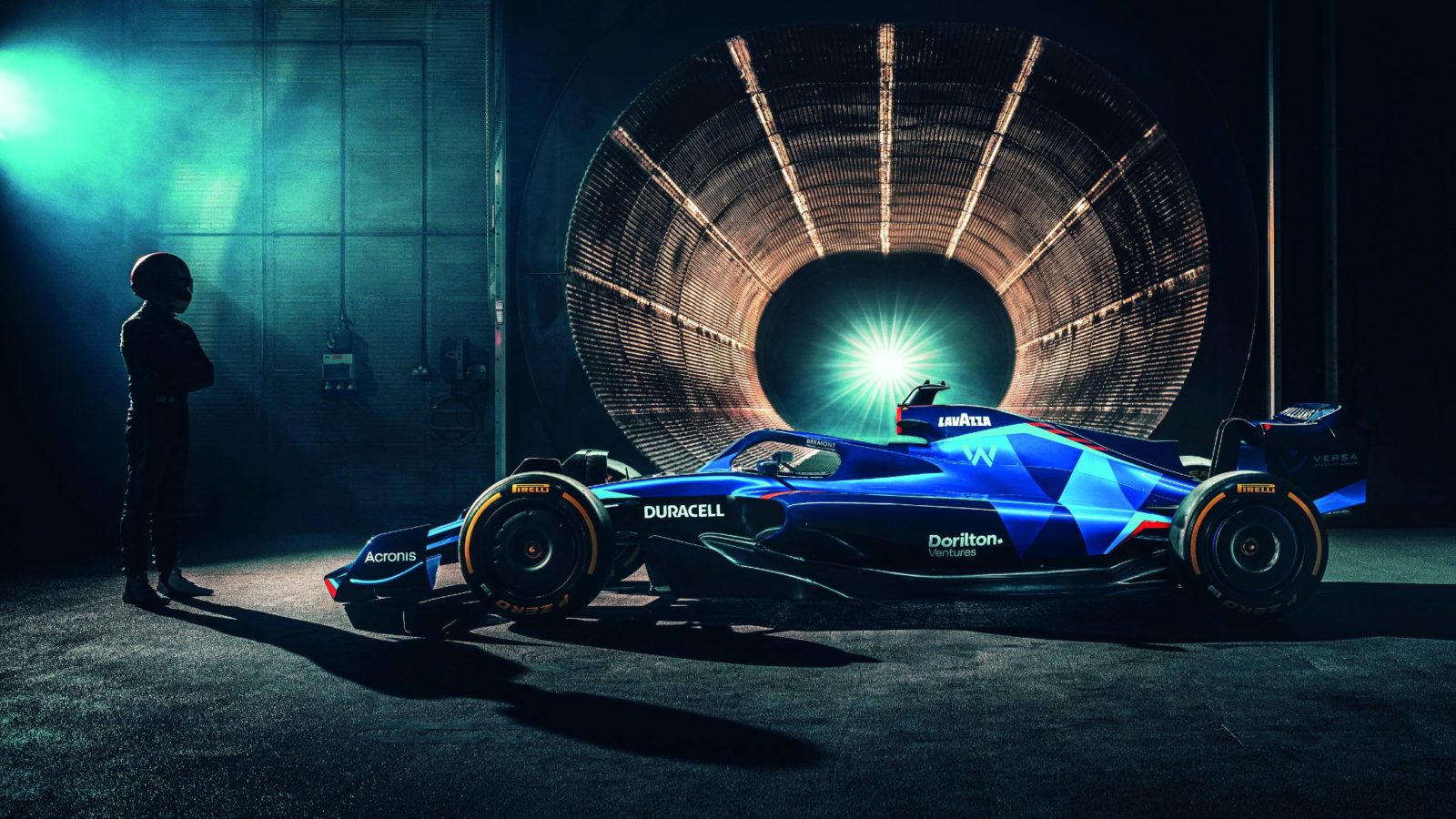
Williams
It’s all about the tech. As the new F1 season gears up ahead of the first race in Bahrain at the end of March, fans have been given their first taste of Formula 1’s much-vaunted new era. It is an era that is supposed to improve the spectacle of the sport by encouraging overtaking and it has been achieved with a forensic examination and re-drawing of the technical regulations. The 2022 cars are a first in the evolution of F1 in that the regulations have been specifically devised with a set objective – of making the cars more raceable. That’s unique. Years of research have gone into this, led by what used to be the Overtaking Working Group, funded by FOM and headed by Pat Symonds and Ross Brawn – perhaps the greatest duo of poacher-turned-gamekeepers in F1 history.
But what are the main changes, how have the teams met the challenges and what will the effect be on track? As ever with F1 there are no simple answers. However, Motor Sport asked Mark Hughes, our grand prix editor, and Craig Scarborough, our technical illustrator and one of the most informed technical experts around, to sit down and discuss the key areas. Both have brought their unique insights and expertise, not to mention off-the-record chats with team engineers, to the table to give us the insider’s guide to F1 ’22.
Aero
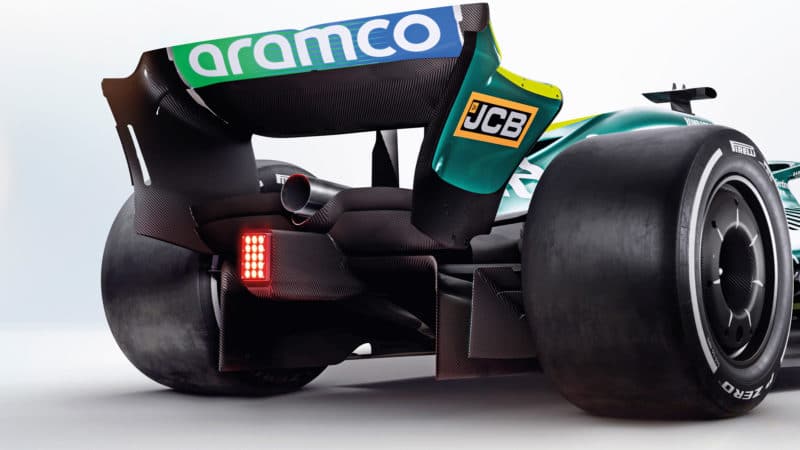
This year features a return to ground-effect aero for the sport
MH: “We are beginning to see the first of these cars breaking cover and in combination with the new larger 18-inch wheels, they are at first glance more aesthetically pleasing than where F1 had evolved to under the old regulations. For one, with the underbody venturi tunnels it seems they need to be run close to the ground both front and rear so that very tail-up high-rake attitude has gone. But the lines themselves look more harmonious too.
“The big worry was that the new regulations are so prescriptive that there would be little to distinguish between the cars, but with four cars launched at the time of writing that is absolutely not the case. With the new Haas, Aston Martin, McLaren and AlphaTauri this could easily be discerned even without their livery. There are very different sidepod and bodywork arrangements. Craig, has that surprised you?”
CS: “Not really. They’ve left quite a lot of big visible areas to play around with – the nose, front wings, sidepods, roll hoop – so the stuff that most people notice will look different between every car. It’s been a while since we had anything other than a generic-looking car and people were expecting this year to be even more generic but actually it’s less so. It’s also remarkable that already they look ‘normal’. Over the years we’ve seen wide cars, narrow cars, high wings, wide wings, the halo – and you think at first it looks weird. But it’s amazing how quickly it becomes the new normal. I don’t even notice the halo now.
“I think in the early stages of these regulations we’ll probably see more visual variation than later. These things tend to converge. But there’s quite a lot of freedom; you can have the nose tip high or low, the middle wing span can be high or low, same as the endplates. You’re trading off wing downforce for flow to the underfloor, so there are lots of different ways.”
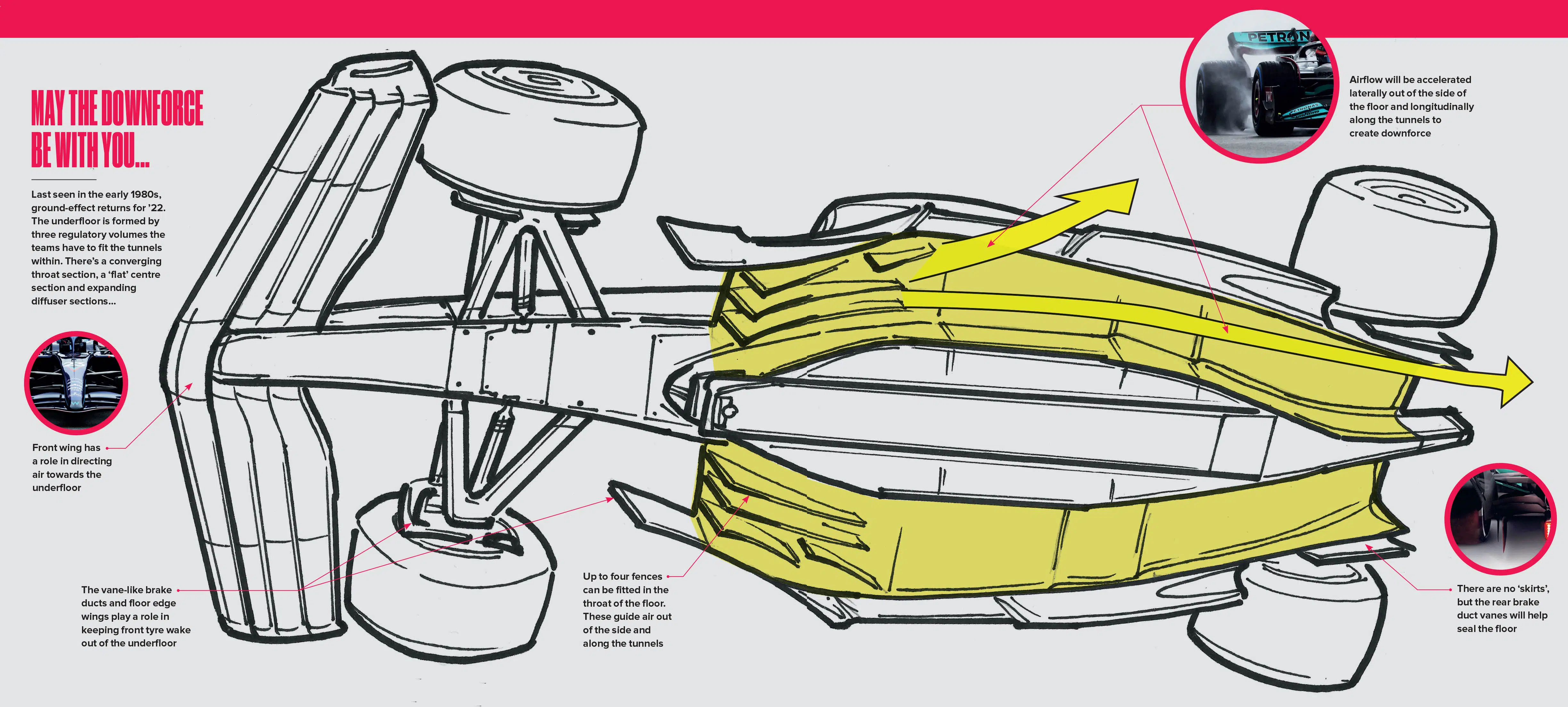
MH: “Yes when we’re talking about the front ends you have to consider it as a package of wing, nose, suspension layout, the sizing and placing of the venturi inlets and radiator inlets. So on the McLaren we’ve seen the first challenge to suspension layout convention – with a move away from what had become the standard pushrod front. They’ve opted for a pullrod layout. These two ways of packaging the inboard rockers have been in and out of fashion over the years but the last time we saw a pullrod front was on a Ferrari in 2015.”
CS: “Yes, many will see it as important because it’s something visual you can use to distinguish between the cars, but from an engineering point it’s just packaging. In performance the effect will be negligible. There’s no more hydraulic actuation of course, and there’s a new regulation defining that the wishbones have to be wide-spanned, not like the very narrow one which Mercedes popularised and which was used to direct the airflow to the underfloor.”
“I wonder if there’s scope for teams to subvert these regulations”
MH: “The pushrod looks like it’s blocking more of the airflow in that area between the front wing and the floor but on the other hand it probably offers more scope to direct the flow. You can offset the arms to help and we see the steering arms are no longer being aligned with the wishbone, suggesting most teams are prioritising directing that flow, especially as the bargeboards are no longer there to help with that. That absence of the bargeboards is a big part of that cleaner look but also critical in giving the car a cleaner wake so that the car behind is not so badly affected.
“The aerodynamics around the front wheels is also legislated to be very different. The crucial thing the regulations are seeking to get rid of is the outwash. They want as much of the airflow as possible going inside the floor and between the rear wheels. Hence we have that big flow-conditioning vane looking like a mudguard and that’s taking the flow and channelling it back towards the centre of the car. I wonder what scope there is for teams to subvert the intent of these regs and find performance by somehow getting that outwash back and thereby giving a cleaner flow to the floor but a disruptive wake once more. Hopefully limited. The FIA had a sort of mini go at this in 2009 but it was nowhere near as fully researched as this and the teams had got around the intent pretty much before the cars had even raced.”
CS: “Teams will want the front tyre wake away from the back of the car. It’s a fundamental thing still. But the toys they have to do that are much more limited now – the front wheel fairings, the brake duct design, furniture on front wing. I don’t think there are enough toys to erode the intent of the regulations. They have been thought about so much better than they were back in 2009. They’ve been designed, tested, gone through another loop of ‘how would we beat this’. The rules have never really gone through that loop before. Previously, big reg changes have had gaping loopholes, like the nose shapes of the early 2000s, shark fins, etc. You know what the teams will try to do. Now a lot of the means of recovery has been taken away from the teams. I think it should work much better.”
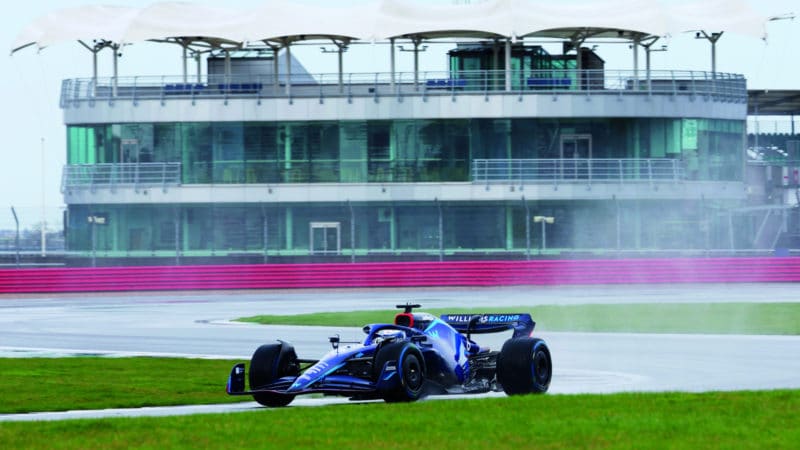
Could we see another Brawn GP moment? Williams will be hoping so…
Williams
Competitive order
MH: “What those 2009 regs also did of course was create the double-diffuser loophole. Or rather they made that idea much more powerful. That completely turned the grid on its head. The former Honda team which had been messing around at the back for two years was suddenly dominating the world championship and the title-winning McLaren team had given Lewis Hamilton a car so bad that he was sometimes struggling even to get it out of Q1.”
CS: “There might always be that Tyrrell moment with the 1990 raised nose or the Brawn moment where someone comes up with something better than the top teams have come up with. But the top teams, despite the budget and tunnel restrictions, will catch onto innovations very quickly. Teams that operate better react better. Resources are a part of it but also it’s the way the team operates. I’m hoping we get a Brawn-type event. But I think even if that happens the likelihood of it carrying all through the season will be limited.”
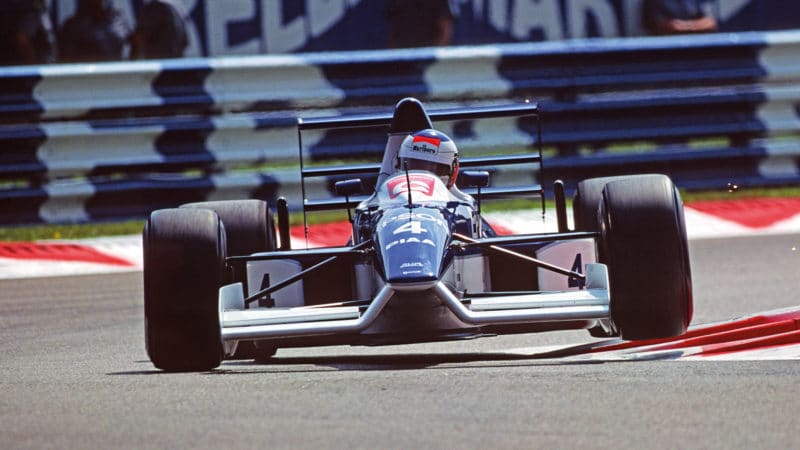
Tyrrell got a boost with its 1990 high nose
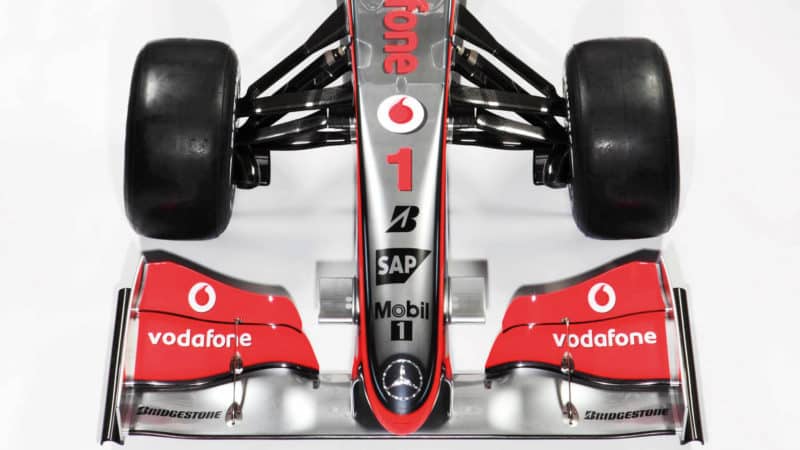
2009 McLaren got it all wrong
MH: “It would be great to think there might be a fundamental innovation from outside the pre-existing top teams. Imagine if, say, Williams had the equivalent of the double diffuser – though it didn’t help them much last time around! “The other thing the regs are trying to do, of course, is reduce the performance gap from the front of the field to the back. But I suspect it’s initially going to be bigger than it was. Last year that gap was on average 2.5sec per lap but that was with a very mature set of aero regs, albeit tweaked here and there. With this reset there’s surely bound to be a bigger initial spread. So I think we’ll have to be careful about assessing whether this objective will have been met. It maybe won’t be for another season or two yet.”
CS: “Yes, even big teams sometimes don’t get it right. Look at 2014, for example. So yes, probably more field spread. I think the teams will converge quicker under these regs though, even if they do get it wrong. I think in the first few races there’s a good chance everyone will be far apart and teams will have so much they are coping with.”
MH: “If it’s like that – with significant gaps between cars’ performance – then the fact that overtaking is easier doesn’t help. In fact it could even make it duller! If any out-of-position faster car can more easily recover because it’ easier to overtake, then the cars are all joined up in their natural performance order sooner. But yes, you’re right about even the big teams getting it wrong with new regulations. Looking back to 2017 with the wide cars and ’19 with the restriction of vanes under the wing and nose, Red Bull got it wrong. Going back to ’09 McLaren got it spectacularly wrong, Ferrari only slightly better and still fundamentally wrong. So it’s not a given the top teams will have the best answers. There’s scope for a lot of volatility as this all plays out through the season.”
CS: “It’s so hard to predict. You hear a lot of positive stuff coming out of McLaren at the moment and also Ferrari. But they are just internal targets they’re referencing. They’ve no idea how those targets measure up tothe others and we wont know really until qualifying in Bahrain.”
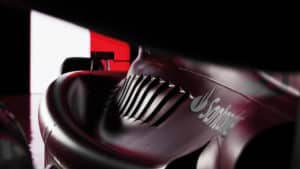
CS: “These regs were created by the F1 tech commission to create a certain lap time, several seconds slower than the ’21 cars. And we’re already hearing these cars will come straight out the box as fast as the old cars ’m sure there will be teams hearing that who will be worried.”
MH: “We now have an inverse restriction on tunnel time and CFD use related to the constructors’ championship. This gives the bottom-placed teams about 15% more research/simulation time than the top teams, though that will progressively stretch to more than that over the next few seasons. That’s another factor pushing towards upsetting the applecart. At least a little.”
CS: “But I think a lot of the smaller teams won’t be running to their maximum allowance anyway because of budget restrictions. The top teams will have a better equipped and organised tunnel, which will allow them to make more out of each run. So it’s still more in balance than the regulations are trying to create. Probably only as that offset gets bigger and bigger each season will you start to notice it. Probably not much difference in that first year. In the second or third year we’ll probably begin to hear Red Bull and Mercedes complaining, ‘If only we had more tunnel time’. It’s something I think will have its effect in time but isn’t an on/off switch for fixing the problems.”
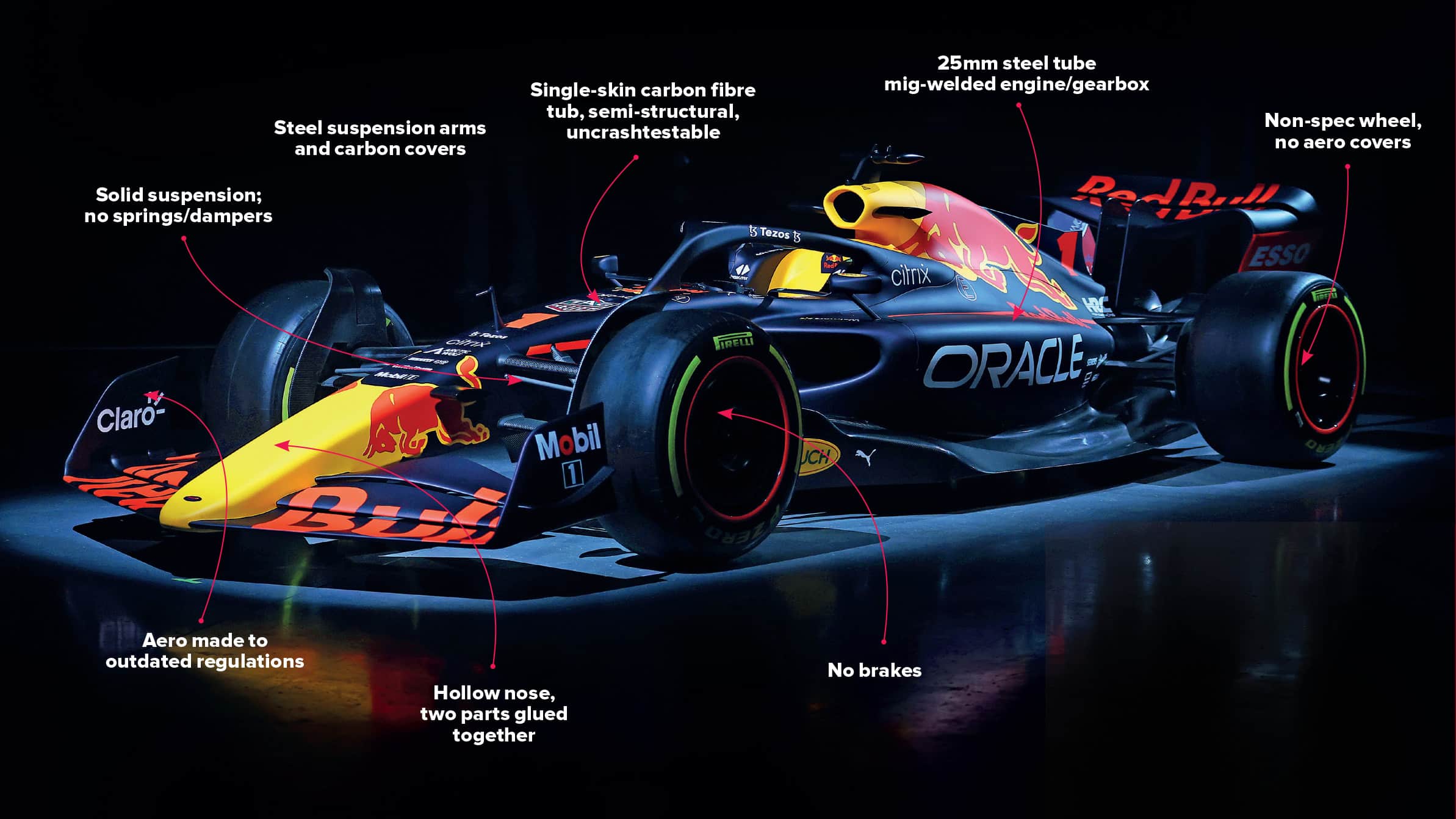
Fake show car launches
In an effort to keep their thinking secret for as long as possible some teams have taken to launching dummy cars made up of fake parts. The only real thing about them are their livery and title sponsor. The worst offender this year was Red Bull, which featured more than a few falsities, identified here by Craig Scarborough. The actual real car wasn’t seen until testing.
Driving traits
MH: “With these venturi tunnels, downforce in fast corners is going to be greater. But at low-speed things are set to be a bit more difficult. Under the old regs the big differentiator between Red Bull/Mercedes and the rest was how well they could retain downforce through long-duration corners – i.e. usually the slower corners. That was all about how well you got the vortices and bargeboards working. Presumably that’s been wiped clean now and it looks like there’s not going to be much scope to get that back – because there’s no furniture there in that area to help. So generically this car is going to be more demanding in the low-speed stuff.”
CS: “With the old cars, for the aero to hang on everything had to be lined up and working. These ones should naturally work really well in yaw at high speed but if they don’t you haven’t got the suspension and aero furniture to claw it back. “Everyone is expecting to have to run these cars low and flat to get the most from the floor. One of the benefits of high rake was how it helped you in slow corners. Equally they don’t have the suspension able to do clever things to compensate. So in terms of philosophy do you derive as much downforce as you can from front and rear wings to help you in these low-speed corners or do you run them like a ground-effect car with much lower drag but suffering in the low-speed stuff? There’s a lot to balance here. Some may go down one route, some another.”
MH: “Low-rake implies stiffer suspension to keep the platform within those tighter limits. That and smaller sidewalls on the tyres all suggests stiffer and more physical to drive. With simpler suspension, there’s a bigger difference in traits between low and high speeds. It sounds a more demanding drive. They’ve lost much of the diffuser stall with the more stringent suspension regs, so you cannot just add wing to get you out of your problems.”
CS: “Yes, and they’ve lost the inerter, which allows you to use a much softer spring. So it’s all down to the spring and damper and rockers, like it used to be. I’ve used the analogy of comparing a ’21 car onboard where it’s all smooth and serene to one from the Senna era where it looks like all hell has let loose, with the car shaking and vibrating. It won’t be as extreme as that as the engineering is so much better now, but I think it won’t be anything like as refined.
“The aero will have to be designed around what you can do with the suspension at its current stage of maturity. You can’t aim for huge amounts of downforce which is very sensitive otherwise it’s going to be a handful.
“Then you’ve got these tyres which will be more on point as you turn in without as much latency and slip. You still have power steering but it’s not quite the same thing. Getting that in initial turn-in and getting that right is going to be more difficult, particularly into slower corners, and it will be interesting to see how much more physical it is and which drivers have that sensitivity to that type of handling. Different drivers don’t like different brakes, they don’t like different suspension set-ups, some of them don’t like certain types of tyre. So it’s going to be splitting the drivers a bit with these cars”.
MH: “We saw the way Kimi Räikkönen never really recovered from the passing of tyre war tyres. When we went to harder, stiffer tyres he never recovered his previous area of advantage. You’re going to have this front tyre which is going to be more keen to turn in as soon as the driver tells it to, a more responsive tyre, but at the same time you’re going to have aero which is less sympathetic to a sudden turn. It’s going to feel a lot different.”
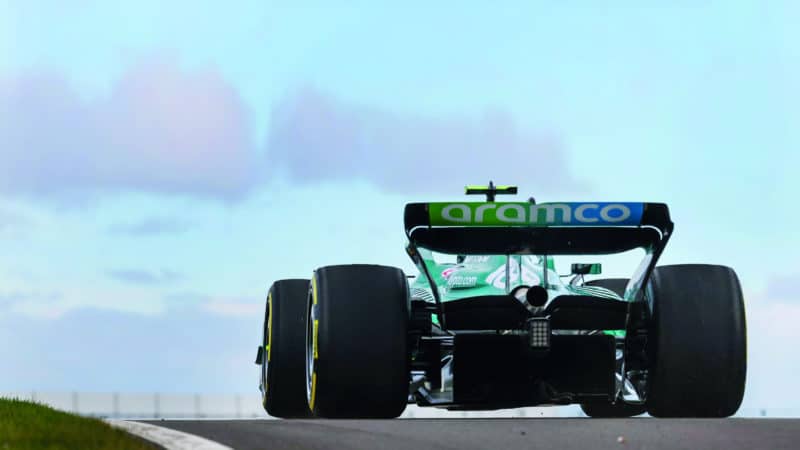
Aston Martin became one of the first to actually run its new car on track when it hit the asphalt at Silverstone on its launch day
DPPI
Tyres
MH: “But all these aero changes are only going to work if the new tyres work. It’s all very well being able to follow more closely for a long time and dice but if the tyres overheat as soon as you get close it’s not going to matter. A lot is hanging on what progress Pirelli has made with these new tyres.”
CS: “It’s a two-way battle between aero and tyres. I think there’s more chance of a team getting the tyres wrong, of not having a car which works them as they need to be worked. But Pirelli has really thought it through, I think. They’ve not just changed the size and aspect ratio, they’ve gone for a taller sidewall to get some of that movement back to generate some heat. A larger tyre will cool quicker so there’s a chance you won’t be able to switch themon. At the back, sliding would always create immediate overheating. They’ve changed the construction to address that. The teams need tyres that you can get quickly into the working window and which then stay there. There’s been lots of testing and there’s been almost no negativity coming out of that. But until you’re actually racing among lots of other cars you might find the fronts are suddenly overheating or the rears are dropping out of temperature range. We just don’t know.
“All these aero changes are only going to work if the new tyres work”
“A problem the teams have is that some of the tools they’ve had to play with tyre temperature have been taken away. Some of the clever stuff with the suspension to try to get the tyres working isn’t there and also – what we’ve seen massively increased in the past 10-15 years – playing with brake ducts to control the temperature of the wheel rim and the tyres. That’s all been taken away. There’s a big air gap between the brake duct bodywork which encloses all of the brake inside the wheel and the wheel itself. That air gap is going to be very difficult to get heat across.
“Some teams might find they are stuckin a position where in cold weather or hot weather they simply can’t get the tyre into its working range at that track. And you’re going to hear lots of soundbites saying it’s unfair we don’t have the ability to look after these tyres. It could even split the haves and have-nots more than the aero. It’ll be very specific to track and weather. Maybe even to the driver.”
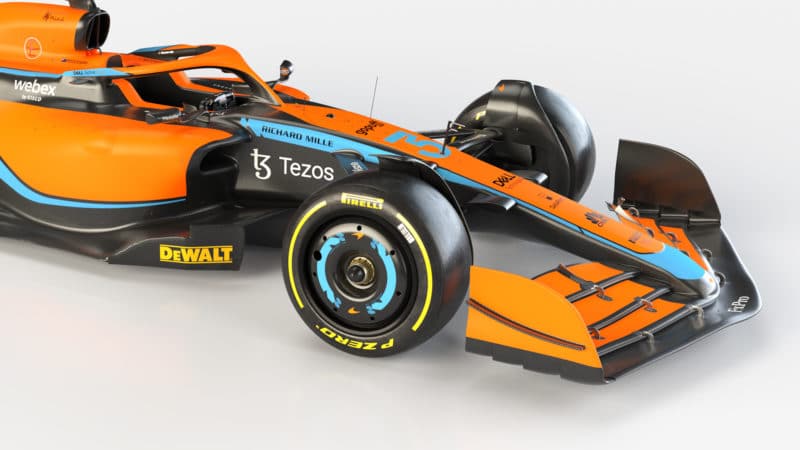
Wheel covers are fine, but the new 18-inch tyres are more interesting this year
MH: “They are also reducing the maximum temperature of the tyre blankets and reducing it year on year and eventually doing away with them. Getting tyres up to temperature but which then don’t overheat will be the challenge. With the old tyres it was often a trade-off between qualifying or race stint. There were tracks where you couldn’t get tyres up to temperature on a flying lap and you could set up your car to alleviate that and bump yourself up the grid but there would be a price to pay on race day. As soon as a driver has to be whole seconds off the pace in the race to get optimum stint lengths, then we’ve got it wrong. I hope we can at least get away from that.
“I can’t believe that with this tyre size and all the research that it will be as bad. But you never know – because these tyres have been created on certain assumptions of what loads the cars would be generating. But already there are concerns about ust how much downforce they are creating in the high-speed corners and the implications that has on the tyre’s structure. Any blow-outs would doubtless lead to a safety-justified regulation tweak.”
Power units
MH: “The power units are effectively frozen from March 1, with the electrical side homologated at the end of September. So for Ferrari and Alpine – both of whom are introducing all-new PUs – it’s the last chance to get the fundamentals right. We also have the introduction of E10 fuel, which is not a small thing for the engine. There’s some scope for disparity there.
“Last year it was generally agreed that the Ferrari was the weakest of the four power units but even they were saying that only 0.2sec of their deficit was from the PU. The rest was from the car. So they were all reasonably closely matched last year. Hopefully the new Ferrari and Renault motors will close that deficit rather than introduce any problems that they didn’t have previously.”
CS: “If you haven’t got it right you’re potentially screwed for the next four years. I think PUs might be the big differentiator this year. It’s unpredictable as we saw with how good the Honda was last year. Also, the genie is out of the bottle to run the engine harder and take penalties rather than stick to three units per year. That’s a legitimate approach.
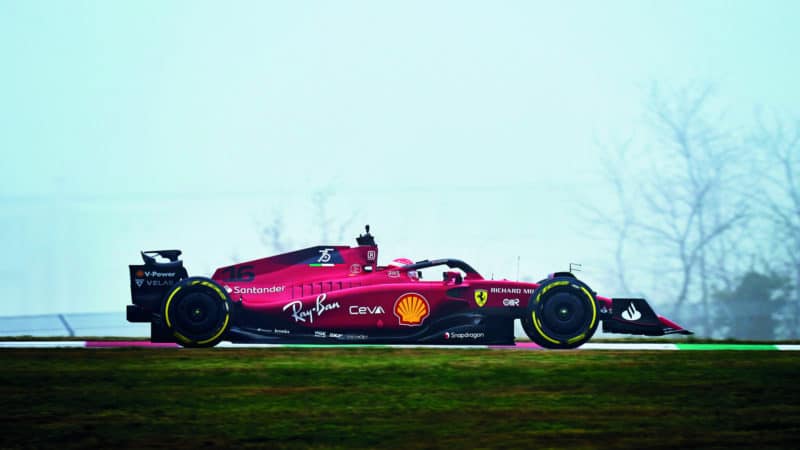
Aside from a return to its fabulous red and black colour scheme of yesteryear, Ferrari has been making big noises about the potential of its new car, with large engine and aero gains expected
Ferrari
“The fuel and oils are homologated, too. That’s always been one of the big steps. How will manufacturers be allowed to react to any imbalance? Remember Renault in the V8 frozen era? They got a dispensation because others had found heaps of performance from reliability upgrades, fuel upgrades, mapping, etc.”
MH: “In terms of the ethanol content I am hearing it’s not been that difficult to claw the peak power back. The initial hit is about 20bhp when you just change fuel. To reclaim ultimate power hasn’t been as difficult as getting good response, especially low revs. That’s been more of a challenge. Which could even add difficulty to those low-speed corners where the driver is having to work the throttle a lot. If they are not getting the response they need or are used to it can be difficult.”
CS: “It’s not just 10% bio content that’s the issue. It’s taken away 10% of all the fun and games that could be played chemically. So it will change how power tails off with miles, the driveability, how hot the engine runs and other reliability factors. The fun stops on March 1 when the fuel has to be homologated.
“I think there will be a lot of PU unreliability in the first part of the year. I think we might be seeing more engines going pop on track than we’ve seen for a few years. Engine blow-ups used to be normal. Now it’s a massive deal. It was unusual if it didn’t blow back in early turbo days. A lot of newer fans don’t appreciate that and get angered at the team if a driver breaks down for any reason.”
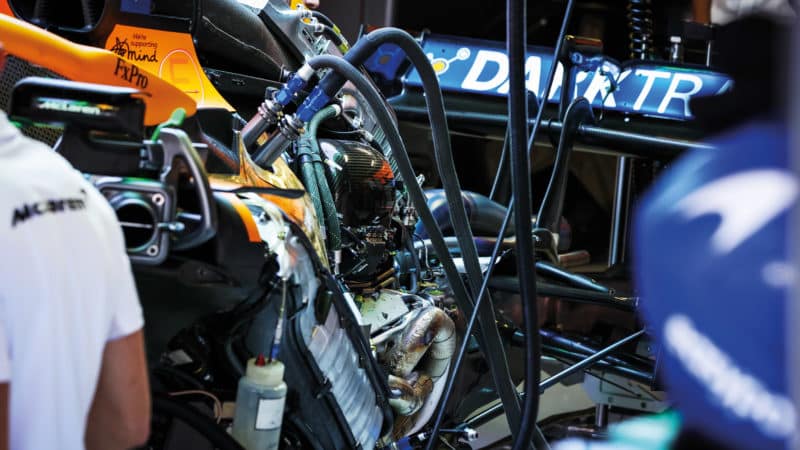
New safety cell aims to further protect drivers from split chassis
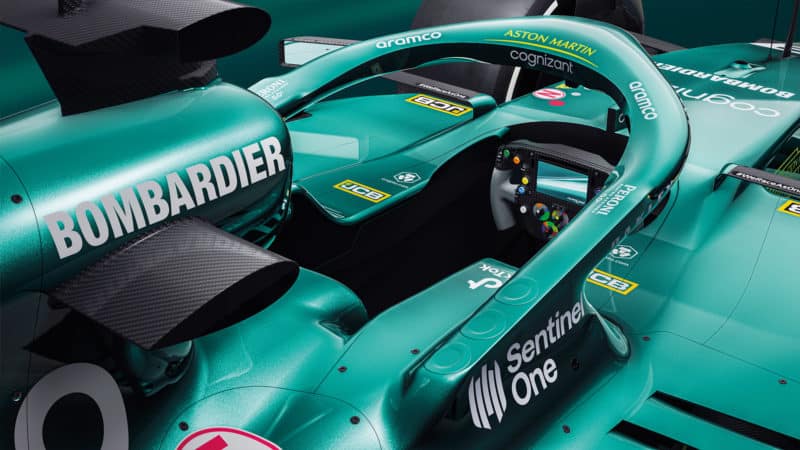
Drivers will enjoy all-round better safety
Safety
CS. “There’s been a raft of the safety changes. There’s the usual incremental load increases in the crash tests. But there’s some reactive changes, too. Between the nose cone and front of chassis there’s an anti-intrusion panel which has been introduced as a result of Billy Monger’s crash where rear crash structure came in through the open front of the chassis. That’s different to hitting a blunt object. This panel has to be tested for intrusion protection – with the equivalent of a rear crash structure coming through it.
“There are changes to the middle of the car from the Grosjean accident. The engine broke from the chassis and took some of the chassis with it including the part that held the fuel filler cap for the bag tank. That’s why we had the fuel fire – the filler cap was ripped off. If that had cracked in a slightly different position that accident wouldn’t have been a fireball. Now the engine mount has to break away at a much lower load, so the engine breaks away cleanly, taking it away from the accident, so the survival cell weighs less, with lower accelerations for the driver to endure. Also the way the filler cap attaches: instead of rigidly through the tub, it’s now attached to the bag tank so if that section of chassis rips away it won’t take the filler with it.”
“There are changes to the pedals also in reaction to the Grosjean accident, so there’s less chance of the foot being trapped. The rear wing and crash structure have to be tethered to the gearbox case so those large parts don’t fly off.”
Final say
MH: “I’m quite excited by all this – because it’s been properly researched. It’s been years in the making, had lots of very clever engineers looking to find ways around the intent and then going through the loop all over again. Repeatedly. There’s a possibility of a reset and of a lot of early volatility. Hopefully the tyres are much better…”
CS: “What, from our point, is the perfect outcome? A Williams or a Haas challenging at the front? A different winner every race, lots of overtaking? I am not sure what we’re aiming for. You can have lots of overtaking but a really dull race. Last year was a fantastic season. But whatever the outcome, it won’t be for lack of trying to get the regs right.
Here’s what’s new for ’22
You’re aware that radical tech changes are afoot – but what do they mean? Here are the crucial differences to the new cars
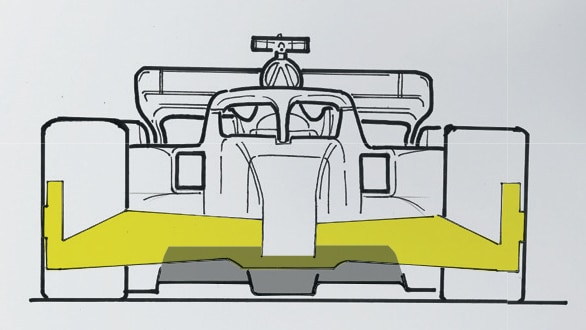
|
Front wingThere is a generous regulatory box for the front wing to sit within. This is already quite high at 100mm off the floor of the car, but teams can choose to raise the wing further within the box. Wing height and how steep the flaps are set need to be sympathetic to the underfloor tunnel behind. |
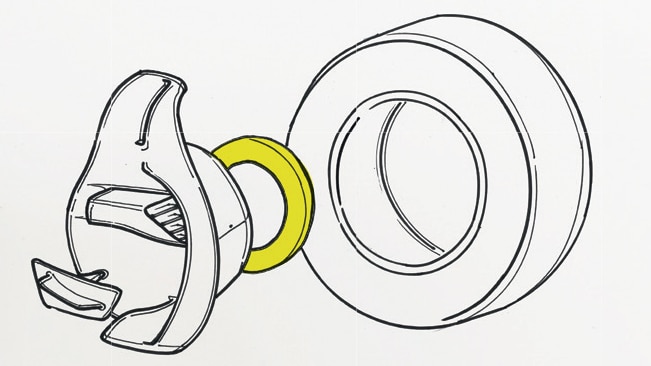
|
BrakesNew brake ducts, tightly prescribed by the FIA, feature outer deflectors to direct the wake of the tyre around the car. Teams can still develop their own scoop and inner ducting to feed the brakes, but are limited in heat transfer from brake to tyre. Brake discs are up to 330mm, wheels grow to 18 inches and tyres are now 720mm diameter |
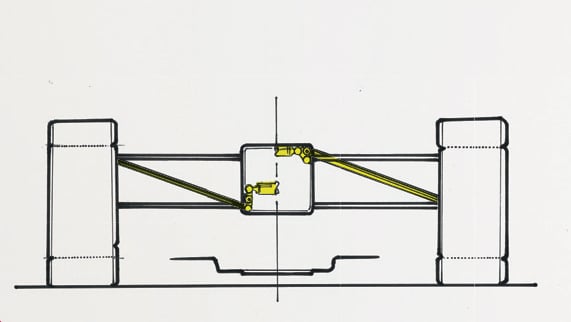
|
SuspensionA change in the profile of the footwell area and the larger wheel opens up opportunities for a different suspension layout. Pushrod at the front and pullrod at the rear have been the fashion for over a decade. Now a switch in both is possible, which can provide aero benefits, although in terms of wheel control neither is superior. Inside, complex hydraulics, gas springs and inerters are banned. Only dampers and springs can form the compliance elements at the rocker |
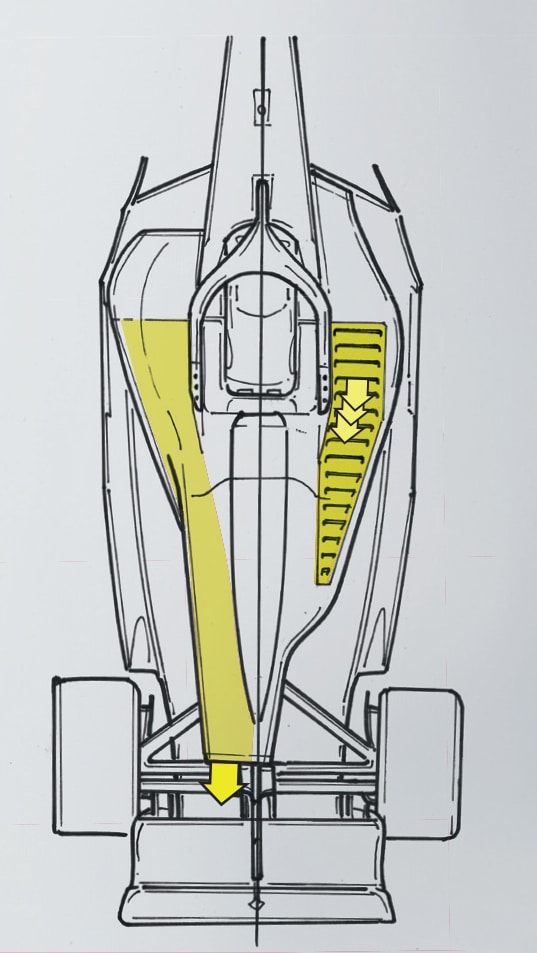
|
SidepodsSidepods can vent their hot air either through (left) a Coke- bottle exit, which creates smoother overbody airflow, but obstructs the tail area, or (right) through newly allowed louvre panels, which allow the tail of the sidepod to be much thinner |
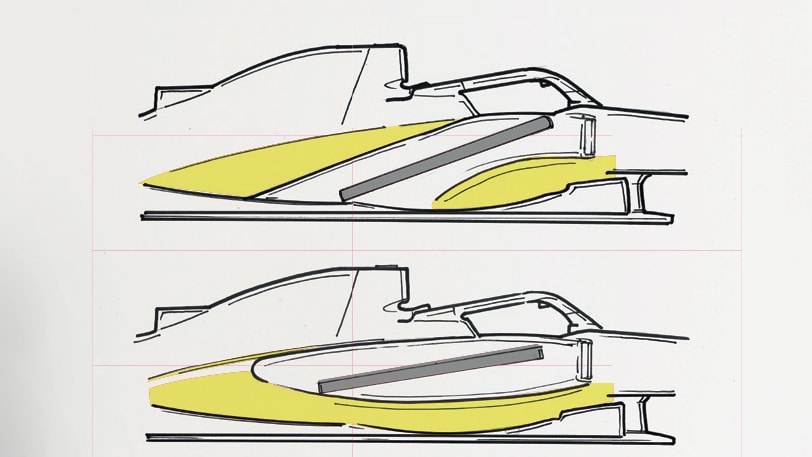
|
RadiatorsWithin the sidepod the radiator layout can indirectly influence the underfloor aero. Normally mounted radiators reach to the floor (top). The undercut in the front of the sidepod can help create downforce, while downwash over the sidepod top helps downforce created at the tunnel exit. Aston Martin has lifted the radiator (above), allowing the undercut to pass under the sidepod. This allows more downforce at the tunnel exit |

